With the Southern Confederacy reeling from multiple military disasters in summer of 1863, President Jefferson Davis set aside Aug. 21, 1863, as a day of Humiliation, Fasting and Prayer. The Confederate chief "invited the people of the Confederate states to repair, on that day, to their respective places of public worship and to unite in supplication for the favor and protection of that God who has hitherto conducted us safely through all the dangers that environed us."
In Chattanooga, a particularly endangered corner of the fledgling nation, worshipers flocked to churches in response to the president's proclamation.
During the services, elements of Col. John T. Wilder's "Lightning Brigade" appeared on Stringer's Ridge, accompanied by a portion of the 18th Independent Battery Indiana Light Artillery, commanded by Capt. Eli Lilly, the future pharmaceutical millionaire.
Wilder's aim was to scout possible river crossings between the mouth of North Chickamauga Creek and Chattanooga, but he apparently could not resist having Lilly's men take a few shots at the town. The shelling caused "much consternation" in the streets.
In one service, the celebrated Dr. B.M. Palmer began a "long Presbyterian prayer" before the shelling started, and opened his eyes at its end to see "a perceptible diminution" in his congregation - one report said he was the only person left in the church. Preaching at another church when the shelling started, Confederate Chaplain C. T. Quintard admitted that his "sermon on that occasion was not long."
The federal shelling inflicted some casualties and property damage in the town. On the waterfront, one steamer, the Paint Rock, was sunk, and another was damaged, along with a Rebel pontoon bridge tied up along the shore for quick deployment. But notwithstanding the "consternation" among the unprepared Rebels, the audacious Federals were not to go unscathed.
A Confederate artillery team took aim at Lilly's position and unleashed a remarkable shot. Henry Campbell, the bugler of the 18th Indiana Battery, described what occurred in his diary:
"I was sitting down just in front of No. 5's gun watching the effects of the shot with the captain's glass. No. 6 had just fired their gun, and at the same instant exactly that the report of our gun rang out through the air and while everyone's attention was engrossed in watching the shot strike, the Rebels fired a shot from a 32-pound James rifle that they had mounted during the time they were silent, in the large fort direct in our front."
Campbell barely escaped injury: "the shell whizzed over my head." Corp. Abram S. McCorkle was sleeping at that point near the trail of the No. 5 gun. Campbell wrote that the Rebel shell cut McCorkle's leg off at the knee, then ricocheted, wreaking havoc with the gun's horse team.
"[First, it] struck the right lead horse of the limber, square in the breast - passed entirely through him endways, striking the next horse just above the chest, passing clear through - hitting the next horse in the throat, splitting his backbone from one end to the other, making its exit just above the tail, the wheel horse in the rear of this horse escaped by having his head down close to the ground - eating grass. But, unfortunately for his mate, the near wheel horse, he had his head around in rear of the off swing horse, and the shell struck him in the side of the head, just below his ears, carrying his brains entirely out, then passed over the caisson, struck a tree and fell to the ground. The horses were killed so suddenly that their mate never moved."
Wilder reported that his guns quickly silenced the deadly Rebel cannon. Poor McCorkle was carried in a blanket to an ambulance, which took him north back to the command's most recent campsite - Poe's Tavern, in what is now Soddy-Daisy. There, he lingered a few days, then died. He was eventually buried in Chattanooga National Cemetery.
Campbell recorded in his diary that the destructive Confederate shell was recovered by Wilder, who eventually sent it to Indiana Gov. Oliver P. Morton. According to the museum's website, it was buried in the collection at the Indiana State Museum in Indianapolis. Identified in November 2013, it is now on display there.
Sam D. Elliott is a local attorney and historian and a member and former chairman of the Tennessee Historical Commission. For more information, visit Chattahistoricalassoc.org.
